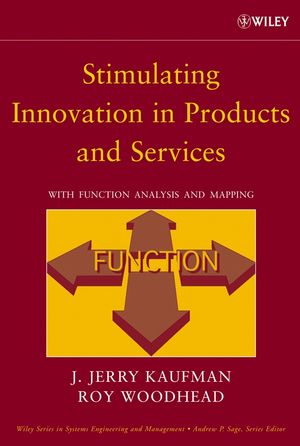Stimulating Innovation in Products and Services: With Function Analysis and MappingISBN: 978-0-471-74060-5
Hardcover
252 pages
March 2006
 This is a Print-on-Demand title. It will be printed specifically to fill your order. Please allow an additional 10-15 days delivery time. The book is not returnable.
|
||||||
PREFACE.
ACKNOWLEDGMENTS.
1. INTRODUCTION.
The Meaning of Function.
Reading FAST.
FAST Logic.
Some Observations.
What Have We Learned?
Applying FAST to Hardware Products.
Reading a FAST Model.
Analyzing a FAST Model.
Some Unique Ways That a FAST Model Has Been Used.
How It All Began.
Toward an Innovation Process.
Who Models Functions?
Why an Interdisciplinary Team?
Team Makeup.
Unlocking Practical Ingenuity.
When Should We Use FAST?
Fundamental Questions.
Distinguishing Between Problem and Opportunity.
Difference Between FAST Diagrams and FAST Models.
Validating Function Models.
Outline of This Book.
2. PROBLEM-SOLVING TECHNIQUES.
Verb–Noun Function Technique.
Fuzzy Problem Technique.
Setting Up the Problem in the Fuzzy Problem Technique.
Hierarchical Technique.
Verb–Noun and Fuzzy Problem Techniques Within the Hierarchical Technique.
Closing Remarks.
3. FUNCTION ANALYSIS.
Function Analysis Syntax.
Active Verbs.
Measurable Nouns.
Using Two Words to Describe Functions.
Defining and Classifying Functions.
Types of Functions.
Extrinsic Functions.
Intrinsic Functions.
Basic Functions.
Secondary Functions.
Practical Definitions.
Rules Governing Basic Functions.
Function Identification Example.
Random Function Determination.
Levels of Abstraction.
Function and Component Selection.
Function Cost Matrix.
Simplifying the Process.
Closing Remarks.
4. FUNCTION ANALYSIS SYSTEM TECHNIQUE.
Process Overview.
Some Misconceptions.
“As Is” Versus “Should Be” Models.
Syntax Used to Create and Read a FAST Model.
Reading How–Why and Our Intentions.
How–Why Versus Why–How Orientation.
Reading When to Consider Causality and Consequential Functioning.
Key Elements of a FAST Model.
Scope Lines.
Highest-Order Function(s).
Lowest-Order Function(s).
Basic Function(s).
Content.
Requirements or Specifications.
Dependent Functions.
Independent (Support) Functions.
Logic Path Functions.
Articulating Theories in FAST.
Variations of How–Why Questions.
Considering And–Or Along the Logic Path.
Considering And in the When Direction.
Considering Or in the When Direction.
FAST Model-Building Process: Product Example.
Expanding the Number of Functions.
Case for Using Active Verbs.
Purpose of Expanding Functions.
Avoiding Duplicate Functions.
Starter Kit Functions.
Preparations for Building a FAST Model.
Build How and Test Why.
Relationship of the Left Scope Line to the Basic Function.
Right Scope Line.
Left Scope Line.
What’s the Problem?
Defining the Problem.
Three Questions Before Starting the FAST Process.
How the Strategic Questions Are Asked in a Workshop.
Symbols and Notations Used in FAST Modeling.
Taking Exception to the FAST Rules.
Independent Functions Above the Logic Path, Activities Below the Logic Path.
No Activities in the Major Logic Path.
Only Two Words Used to Describe Functions.
Loop-Back Modeling.
Validating the Logic Flow.
Exploration Drilling Model.
Closing Remarks.
5. DIMENSIONING THE FAST MODEL.
Pre-event Stage.
FAST Dimensioning Themes.
Business Process and Soft Issues.
Sensitivity Matrix.
Facility Management Case Study.
Determining Responsibility, Move to Action.
Incorporating Other Dimensions in FAST Models.
RACI/RASI Dimensioning.
FAST and Organizational Effectiveness.
Organizational Effectiveness Case Study.
Model the Future or the Present?
Incorporating Additional Dimensions.
Product- and Equipment-Based FAST Models (Artifacts).
Sensitivity Matrix in Product (Artifact) Analysis.
Staple Remover Case Study Using FAST With the Sensitivity Matrix.
Determining Component Function–Cost Details.
Proposed Solution.
Pipeline Case Study Using the Sensitivity Matrix.
Other Case-Specific Dimensions.
Budgeting Operating Expenses and the Sensitivity Matrix.
Clustering Functions.
Example Using Clustering.
Closing Remarks.
6. ATTRIBUTES AND THE FAST MODEL.
Defining an Attribute’s Range of Acceptance.
Ranking Attributes.
Incorporating Attributes Into a FAST model.
Linking Issues of Concern to a FAST model.
Construction Management Case Study.
Influence of Attributes and Incentives on FAST Modeling.
Software Acquisition Case Study.
Validity of a FAST Model.
Pre-event’s Role in FAST Modeling.
Areas Defined by a Scope Line.
Resolving the Incentive Issue.
Determining the Incentive Earned Points Score.
Closing Remarks.
7. ENABLING INNOVATION.
Analyzing FAST Models.
Distinguishing Outcomes and Ideas.
Starting to Generate Ideas.
Handling Negative Functions.
Examples of Negative Functions.
TRIZ and Negative Functions: Path to Creativity.
Defining Problems: Prerequisite to Seeking Solutions.
Problem Set Matrix.
Identifying Critical Innovation Points.
Realizing Innovation Through FAST Models.
Toward Innovation That Makes a Difference.
Importance of the Pre-event Phase.
XYZ-3 Case Study.
Defining XYZ-3’s Problems.
Setting Project Goals.
Selecting Attributes.
Selecting Random Functions.
Constructing the FAST Model.
Selecting Functions to Be Brainstormed.
Using FAST for Brainstorming.
Concluding the XYZ-3 Value Study.
Closing Remarks.
8. FROM COMPETENCY TO CAPABILITY.
Moving Toward Know-How and FAST models.
Beyond Intuition.
Discovering New Knowledge.
Management of Functionality.
Using FAST Modeling to Improve the Supply Chain.
Using FAST Modeling to Enable Shared Understanding.
Managing Intangible Value to Advantage.
Automotive Parts Case Study.
How Can We Unify?
Functional Enquiry.
Closing Remarks.
END NOTES.
REFERENCES.
APPENDIX: FREQUENTLY ASKED QUESTIONS.
INDEX.



